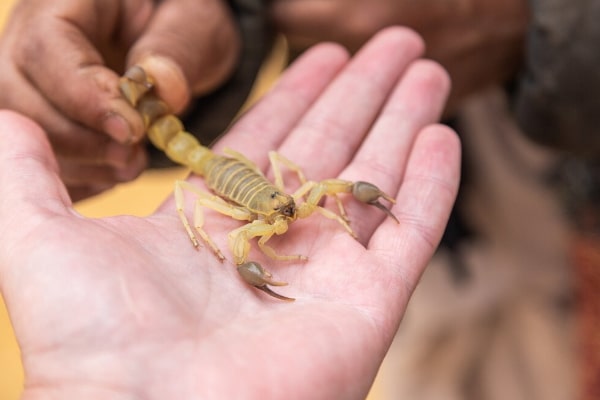Many people in the Phoenix area assume that every scorpion they come across is an Arizona bark scorpion. That’s not necessarily the case.
Arizona is home to dozens of species of scorpions. While all scorpions have venom that they might use to capture their prey, not all scorpions have venom that is harmful to humans and animals. Arizona doesn’t have the largest scorpions in the world nor the deadliest scorpions in the world, but it does have a scorpion with a rather potent venom: the Arizona bark scorpion. At best, a sting from that scorpion can be rather annoying, or, at worst, the scorpion sting can be extremely painful with longer lasting effects. Deaths from scorpion stings are very rare. People who are prone to have allergic reactions to stings, and those with undeveloped or compromised immune systems (the very young and very old), may have strong or severe reactions. Small pets may also have adverse reactions.
The Sonoran Desert covers an area of about 100,000 miles and includes southeastern California, most of Baja California and Baja California Sur, parts of northwestern Mexico including the cities of Guaymas, Hermosillo, and Puerto Peñasco (Rocky Point), and much of the southern half of Arizona, including the cities of Tucson, Yuma, and Phoenix.
Below you’ll get some tips on how to identify the four most common types of scorpions that you are likely to find in the Sonoran Desert.
Bark Scorpion

Centruroides sculpturatus is the well-known Arizona bark scorpion. It is readily distinguished from all other scorpions in the area by having long, slender hands and fingers, along with a long, slender tail or metasoma. In the desert, it is typically uniform tan-yellow to orange; at higher elevations, it may be striped. When at rest, the metasoma is held at the side and coiled to where the sting is directed to the base of the fourth segment. Occasionally in males, it is coiled horizontally over the body. Metasoma segments are subequal in length, long and slender in males. The Arizona bark scorpion is very common in rocky areas in the desert and found throughout Arizona.
Things to Know About Arizona Bark Scorpions
- Family: Buthidae
- Usually about 2 – 3 inches long
- Nocturnal
- Give birth to their young live, about 25-35 at a time
- Eat crickets, roaches, and other insects
- If you find one, there are probably more
- Just because you see them in the pool, don’t assume they have drowned
- They can climb rough surfaces
- Arizona bark scorpions are said to be the most common scorpions found inside homes in the Phoenix area
Giant Hairy Scorpion

Hadrurus arizonensis is the popular Arizona giant hairy scorpion, the largest scorpion in the United States. Hairy scorpions are just that: hairy. The metasoma and pedipalps are densely covered in setae (hairs). No other American scorpions have such a dense covering of setae on the appendages. The pedipalps and metasoma are also relative in size; not robust, not slender. Dorsal surface dark; appendages yellowish, appearing greenish due to slight fluorescence. Interocular area of carapace unpigmented in the crescent from median to lateral eyes. The Arizona Giant Hairy Scorpion digs deep burrows or lives under surface objects. In Arizona, it is found in saguaro forests.
Things to Know About the Arizona Giant Hairy Scorpion
- Family: Iuridae
- Can be more than 4 inches long
- Also called the Giant Desert Hairy Scorpion
- Eat small lizards, other scorpions, spiders, centipedes, and other insects
- Burrow to find water
Stripetail Scorpion

Vaejovis spinigerus is commonly called the Arizona stripetail scorpion. It is easily distinguished from all other Arizona scorpions by having a fairly robust, lustrous metasoma with keels that have underlying pigment, hence the name, stripetail scorpion. The dorsal keels on the metasoma terminate in a distinctly spinoid granule, which gives it the name “spinigerus” or “spine bearing”. The body is usually lustrous, the hands are smooth and lustrous, occasionally with the palm inflated. Color ranges from light yellow-brown to having dark stripes along the dorsum, which extend onto the carapace to the median eyes and lateral eyes, with the stripes forming a somewhat horned appearance. Females have been known to reach 70 mm, but are usually under 60 mm or 3 inches.
Things to Know About the Arizona Stripetail Scorpion
- Family: Vaejovidae
- Usually under 3 inches long, and females are generally larger than males
- May also be called the Arizona stripe-tailed scorpion
- Arizona’s most common species of scorpion, usually found under rocks
Yellow Ground Scorpion

Vaejovis confusus is commonly called the yellow ground scorpion. It is yellowish and granular. It has slender hands and fingers, similar to the Arizona bark scorpion, but the first two metasoma segments are wider than long or as wide as long. Found throughout the Sonoran Desert where it burrows or digs scrapes under rocks or other objects.
Things to Know About the Yellow Ground Scorpion
- Family: Vaejovidae
- Nocturnal
- Found from southeastern Arizona all the way to Idaho and southeastern Washington in the Sonoran and Great Basin deserts





Leave a Comment